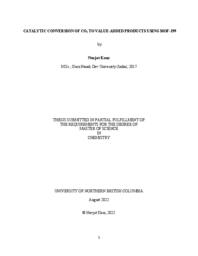Kaur, Navjot
Person Preferred Name
Navjot Kaur
Related Works
Content type
Digital Document
Description / Synopsis
With the increase in carbon dioxide emissions into the environment, there is an increased need to capture carbon dioxide (CO2). One method of removal of CO2 that has been receiving more attention is its conversion to useful chemicals. Metal organic frameworks (MOFs) are promising candidates in catalysis because of their remarkable properties such as great surface area, high stability, active sites, porosity, tunability and affinity for CO2. In this study metal organic framework i.e., MOF-199, developed by solvothermal and evaporation-induced self-assembly (EISA) techniques, was used to catalyze the reaction between CO2 and epoxides such as propylene oxide (EP1), styrene oxide (EP2), epichlorohydrin (EP3), and 1,2-epoxybutane (EP4). The corresponding carbonates are obtained by using tetrabutylammonium bromide (TBAB) as a co-catalyst. The synthesized MOF-199 was characterized by X-ray diffraction, Fourier transform infrared spectroscopy, thermal gravimetric analysis, scanning electron microscopy, and Brunauer-Emmett-Teller analysis. More than 65% conversion of epoxides (EP1, EP2, EP3, and EP4) to their corresponding carbonates were obtained under mild reaction conditions (100°C and 70 psi) over the synthesized MOF-199 catalysts (1S, 2E, 3E, and 4E), and co-catalyst (TBAB). The percentage yields of cyclic carbonates were determined by using 1H-NMR spectroscopy. The synthesized MOF catalysts demonstrated the high catalytic activity for the chemical fixation of CO2 to cyclic carbonates at mild reaction conditions.
Origin Information
Content type
Digital Document
Description / Synopsis
Suicide is a global health issue that involves the biological, social, cultural, spiritual, and psychological state of an individual in addition to many other factors which interact and lead a person to Suicidal Ideation (SI) and Suicide Attempt (SA). Over the last decade, with the advent of large medical databases, there has been a tremendous rise in the use of Business Intelligence (BI) in the healthcare sector. Healthcare uses BI tools to transform raw data into meaningful information to extract the potential value of historical data. Timely diagnoses of mental health problems can assist experts to address it at an early stage and enhance patient’s quality of life. There is a critical need to examine the fundamental psychological well-being issues among the worldwide population, which may develop into more complex issues, if not considered at an early period. This research focuses on two main components: Data visualization and Predictive model. First, a mental health dashboard is created using an end to end approach in which mental health data is pre-processed, integrated, and visualized in the form of several reports. These reports display the aggregated results in visually appealing formats (i.e., graphs, tables, pie charts, and line graphs) and allow navigation to finer granularity reports via drill down and drill through reports. Second, a predictive model is built to forecasts Suicide Attempts (SA). Ontario Mental Health Reporting System (OMHRS) database obtained from CIHI (Canadian Institute for Health Information) is used to train and test the predictive model. This model uses advanced data mining algorithms, including Artificial Neural Networks, Decision trees, and regression. The outcomes of different data mining algorithms are compared with actual values to determine the accuracy of the model. In addition, a web form is created, which takes input from the user and calculates the probability of SA for a given patient. The objective of this research is to provide a better understanding of trends, outliers, and patterns to enable healthcare providers to make more informed decisions and decrease mortality rate due to suicide.
Origin Information


